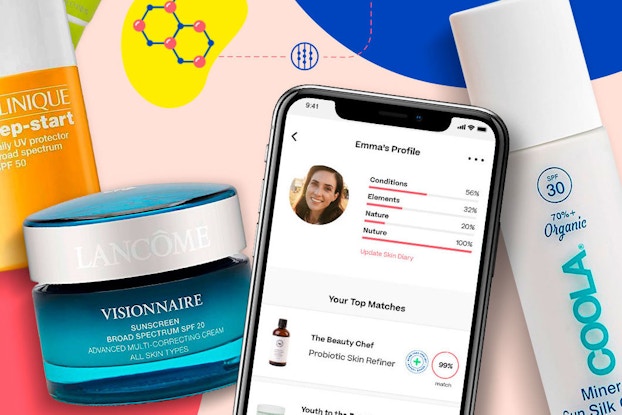
The meaning of unregulated words like “organic,” “natural” and “clean” in the beauty and food space have become cloudy and largely up to the consumer herself to define.
The Good Face Project has set out to clear that all up in the beauty aisle.
The startup, co-founded in 2018 by Iva Teixeira and Lena Skliarova-Mordvinova, is a digital tool dedicated to identifying, cataloging and clarifying the ingredients in cosmetics and personal care products, with an eye on ultimately creating a cleaner, healthier beauty industry. And the company has already earned an important champion: In 2020, it was chosen for Target’s competitive Accelerators program, which grooms entrepreneurs the trendy discounter believes are shaping the future of commerce.
In an often-overwhelming sea of marketing and social media content, the goal of the Good Face Project is to empower consumers to make beauty purchasing decisions that are informed by more than just advertising and (often altered) images posted by influencers and celebrities.
“We know that when information is displayed in the appropriate way without making it vague, but also without making it overwhelming, the consumer will make the right choices for herself and for her family,” Teixiera told CO—. “We focus on data, science and the right way to inform.”
Major growth in the beauty sector has more brands than ever competing for shelf space and wallet share. Skincare itself is expanding at a CAGR [compound annual growth rate] of 4.4%, set to reach an estimated $183 billion by 2025, according to Grandview Research, with “clean” beauty up 39% year-over-year in 2019, according to Larissa Jensen from NPD Group.
Conquering the Wild West of the U.S. beauty market
Both of the Good Face Project’s co-founders come from a professional background in the sciences, making them uniquely attuned to certain realities of the beauty industry. Skliarova-Mordvinova, the startup’s chief technology officer, was a scientist for the Ukrainian Space Research Institute. Teixeira trained as an industrial engineer, in addition to holding an MBA.
Before her life as an entrepreneur, Teixeira worked as a consultant for industry players including Bain & Company. Her inspiration for the Good Face Project came from one such consulting project, conducting market research for a large beauty brand.
Interviewing over 100 women about their needs and preferences when it came to cosmetics and personal care, she found two resounding demands: first, that products were not going to cause any physical harm to her or the family members she was shopping for. Second was the need for a more curated shopping experience that could help her choose from an ever-growing assortment of brands and products available on store shelves.
“So, with that insight, I started digging through what is going on in the industry,” Teixeira said. Investigating the long list of ingredients in her children’s sunscreen, she discovered known carcinogens as well as an agent found to cause hormone disruption. She also discovered a notable lack of regulation in the U.S. cosmetics and personal care market.
“In the in the European Union,” she explained, "there are about 1,300 ingredients that are not allowed in personal care and cosmetics, whereas in the United States, very few of them are actually prohibited.” According to the FDA, fewer than a dozen ingredients are currently banned or restricted.
Target is looking for ways to provide transparency to their guests and to help educate which products can be good for you, and at the same time to do it in a really, really honest way. Our mission to provide that type of transparency on our own platform is really at home at Target, with their mission to do the same in beauty for their guests.
Iva Teixeira, co-founder and CEO, Good Face Project
How the Good Face Project works for both consumers and corporate clients
Teixeira next searched for anyone creating an encyclopedia of cosmetic ingredients, with the ability to search by ingredient for a product and vice versa. “I found a couple of solutions that were not all encompassing and that were quite polarizing with a bit of a political agenda, lobbying against big beauty,” she said, “which I just didn't feel was also the right thing to do.”
So, in the absence of a good solution, she founded one herself. Teixeira and Skliarova-Mordvinova developed a proprietary methodology, analyzing over 100,000 ingredients, then tagging them against 15 “dimensions of safety and accuracy,” which have been identified using over 21,000 different scientific sources.
So far, the engine has collected and rated product formulations for 76,000 individual products from over 4,500 brands. Inputting their own priorities and preferences, users receive customized recommendations along with detailed information about product ingredients. Featured brands certified by the Good Face Index include 100% Pure, Odele (currently a Target exclusive) and Ursa Major.
“We developed the largest and first-of-its-kind ingredients-based recommendation engine for cosmetics,” said Teixeira, “that acts almost as a Pandora radio for skincare.”

The growing importance of transparency in today’s retail landscape
From food to apparel, consumers are increasingly expecting new levels of transparency from the brands and retailers they shop, bringing a new level of skepticism to what they buy and where they buy it. According to research by Edelman, only 34% of consumers surveyed trust most of the brands they buy. The same study found that ingredients are a deciding factor for 82% of consumers.
For this reason specifically, Good Face Project’s database presents a timely tool for cosmetics manufacturers and large retailers, like Target. The platform is free for consumers to find recommendations, but monetizes its database via its relationships with retailers, brands and manufacturers. “We're basically in the business of information arbitrage,” Teixeira said. “We exchange information and data for value back to us.”
For a manufacturer, the Good Face Project’s database acts as a subscription-based, SaaS (software as a service) platform, enabling the client to use it as they would use Google or Salesforce in formulating a new product. Retailers, who use the tool as an API (application programming interface), collating their inventory against the Good Face Project’s database, are charged on the basis of data transmission. Brands that meet the Good Face Project’s requirements can pay to have their products certified within the consumer-facing platform.
Teixeira believes that beauty is the next frontier of wellness culture, and that transparency is the first step to help Target and other retailers cater to new consumer demands.
“Target is looking for ways to provide transparency to their guests and to help educate which products can be good for you, and at the same time to do it in a really, really honest way,” Teixeira said. “Our mission to provide that type of transparency on our own platform is really at home at Target, with their mission to do the same in beauty for their guests.”
CO— aims to bring you inspiration from leading respected experts. However, before making any business decision, you should consult a professional who can advise you based on your individual situation.
Follow us on Instagram for more expert tips & business owners stories.
CO—is committed to helping you start, run and grow your small business. Learn more about the benefits of small business membership in the U.S. Chamber of Commerce, here.
CO— Exclusives: Insider Strategies
How the buzziest brands and hottest startups are solving today's biggest business challenges. CO— brings you advice from startup founders and top executives for thriving in a new world.








